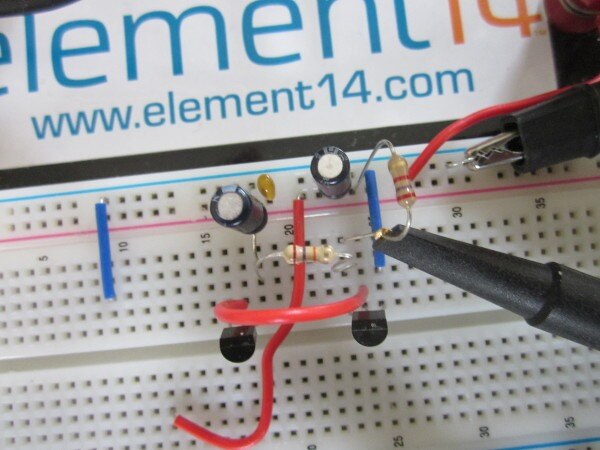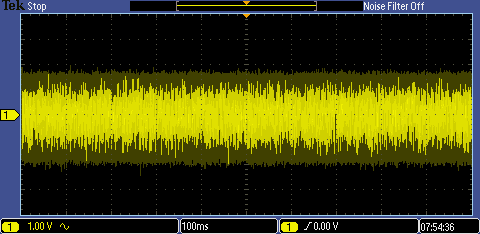22nd May 2021
I've just been playing with a very simple noise generator and that's the result.
The digital phosphor of the oscilloscope presents multiple traces of the waveform as though it were sketched with a pencil or crayon.
In case it's of any interest, here's the circuit:
The internet is full of variations, with either a Zener, reverse-biased LED, or reverse-biased base-emitter junction as the avalanche 'noise diode'.
For these traces I used a reverse-biased base-emitter junction (the transistor on the left with two pins connected - the other transistor is working as a common-emitter amplifier)
and it produced a very good level of noise out on a 12V supply.
At lower frequencies (the scope is AC-coupled for these), the noise looks quite noise-like. Like this:
but if I go back to the start and show you a single trace of the first waveform, we see this
so we're now looking at a time scale where we can see the avalanching stopping and starting.
Update 4th June 2021
What started as a throwaway blog about an interesting/amusing waveform seems to have taken on a life of its own.
Thanks for all the useful comments below. They've had the useful effect of forcing me to rethink some of this.
1. The original circuit that I copied had an integrator (low-pass filter) in the feedback of the common-emitter stage
[the 27k and the 10uF] to set the DC bias voltage. That means that the resulting overall transfer characteristic will
be high-pass [the inverse]. I should have considered that a bit more at the time. If I simulate it with this following
circuit (I've substituted a simple signal generator, with an 8V DC offset on it, for the 'noise diode' which is the input to the circuit)
I get this for the response
That won't be entirely right - the simulation is small-signal and the generator is working large-signal - but it lets us
see in a rough way what's happening and understand it in general terms. It falls off from a few hundred Hertz downwards.
That means I'm going to see very little of the low frequency noise as the circuit will integrate it away. Indeed, if I had wanted
to use the generator circuit for audio, it would probably have been better if I had moved the low end cut-off down by
another decade [100uF might do instead of the 10uF].
At the top end, that plot shows quite nicely that the response is determined largely by the amplifier transistor running
out of steam and that will depend to some extent on the individual transistor.
2. In my reply to Shabaz in the comments, I suggested that seeing the noise decline as I filtered it with the 'scopes
noise filtering meant that it wasn't white noise. That is quite wrong and I need to correct it. Since random noise level
is a function of bandwidth, if I restrict the bandwith, I lessen the noise seen. That doesn't mean that it's necessarily
'white' noise [equal power per unit of bandwidth], but it most certainly doesn't mean the opposite [that it's not].
In Motchenbacher and Fitchen, they suggest that avalanche noise is white but that there is also excess noise
in the form of multistate noise that is predominently l/f. This is in a section comparing the noise performance
of zener and avalanche diodes, though I presume a reverse-biased base-emitter junction is similar.








Top Comments
-

fmilburn
-
Cancel
-
Vote Up
+5
Vote Down
-
-
Sign in to reply
-
More
-
Cancel
-

jc2048
in reply to fmilburn
-
Cancel
-
Vote Up
+2
Vote Down
-
-
Sign in to reply
-
More
-
Cancel
-

fmilburn
in reply to jc2048
-
Cancel
-
Vote Up
+4
Vote Down
-
-
Sign in to reply
-
More
-
Cancel
-

fmilburn
in reply to jc2048
-
Cancel
-
Vote Up
+4
Vote Down
-
-
Sign in to reply
-
More
-
Cancel
Comment-

fmilburn
in reply to jc2048
-
Cancel
-
Vote Up
+4
Vote Down
-
-
Sign in to reply
-
More
-
Cancel
Children